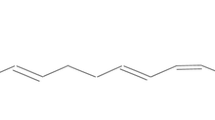Abstract
The mycotoxin ochratoxin A is a secondary metabolite occurring in a wide range of commodities. During the exposure of ochratoxin A to white and blue light, a cleavage between the carbon atom C-14 and the nitrogen atom was described. As a reaction product, the new compound ochratoxin α amide has been proposed based on mass spectrometry (MS) experiments. In the following study, we observed that this compound is also formed at high temperatures such as used for example during coffee roasting and therefore represents a further thermal ochratoxin A degradation product. To confirm the structure of ochratoxin α amide, the compound was prepared in large scale and complete structure elucidation via nuclear magnetic resonance (NMR) and MS was performed. Additionally, first studies on the toxicity of ochratoxin α amide were performed using immortalized human kidney epithelial (IHKE) cells, a cell line known to be sensitive against ochratoxin A with an IC50 value of 0.5 μM. Using this system, ochratoxin α amide revealed no cytotoxicity up to concentrations of 50 μM. Thus, these results propose that the thermal degradation of ochratoxin A to ochratoxin α amide might be a detoxification process. Finally, we present a sample preparation and a HPLC-tandem mass spectrometry (HPLC-MS/MS) method for the analysis of ochratoxin α amide in extrudates and checked its formation during the extrusion of artificially contaminated wheat grits at 150 and 180 °C, whereas no ochratoxin α amide was detectable under these conditions.




Similar content being viewed by others
References
Beyer M, Dänicke S, Rohweder D, Humpf HU (2010) Determination of deoxynivalenol-sulfonate (DONS) in cereals by hydrophilic interaction chromatography coupled to tandem mass spectrometry. Mycotoxin Res 26(2):109–117
Bittner A, Cramer B, Humpf HU (2013) Matrix binding of ochratoxin A during roasting. J Agric Food Chem 61:12737–12743
Bretz M, Beyer M, Cramer B, Knecht A, Humpf HU (2006) Thermal degradation of the Fusarium mycotoxin deoxynivalenol. J Agric Food Chem 54:6445–6451
Brown MH, Szczech GM, Purmalis BP (1976) Teratogenic and toxic effects of ochratoxin A in rats. Toxicol Appl Pharmacol 37:331–338
Castells M, Pardo E, Ramos AJ, Sanchis V, Marin S (2006) Reduction of ochratoxin A in extruded barley meal. J Food Prot 69:1139–1143
Commission E (2006) Commission regulation No 1881/2006 of 19 December 2006 setting maximum levels for certain contaminants in foodstuffs. Off J Eur Union L364:5–24
Cramer B, Königs M, Humpf HU (2008) Identification and in vitro cytotoxicity of ochratoxin A degradation products formed during coffee roasting. J Agric Food Chem 56:5673–5681
Cramer B, Harrer H, Nakamura K, Uemura D, Humpf HU (2010) Total synthesis and cytotoxicity evaluation of all ochratoxin A stereoisomers. Bioorg Med Chem 18:343–347
Entwisle AC, Williams AC, Mann PJ, Slack PT, Gilbert J (2000) Liquid chromatographic method with immunoaffinity column cleanup for determination of ochratoxin A in barley: collaborative study. J AOAC Int 83:1377–1383
European Commission Scientific Committee for Food (2002), SCOOP task 3.2.7. Reports on tasks for scientific cooperation: assessment of dietary intake of ochratoxin A by the population of EU Member States. Available from: http://ec.europa.eu/food/fs/scoop/3.2.7_en.pdf (Accessed 17 December 2014)
European Food Safety Authority (EFSA) (2006) Opinion of the scientific panel on contaminants in the food chain on a request from the commission related to ochratoxin A in food. EFSA J 365:1–56
International Agency for Research on Cancer (IARC) (1993) Some naturally occurring substance: some food items and constituents, heterocyclic aromatic amines and mycotoxins. IARC Monogr Eva Carcinog Risks Hum 56:489
Ishiyama M, Tominaga H, Shiga M, Sasamoto K, Ohkura Y, Ueno KA (1996) Combined assay of cell viability and in vitro cytotoxicity with a highly water-soluble tetrazolium salt, neutral red and crystal violet. Biol Pharm Bull 19:1518–1520
Jalili M, Jinap S, Son R (2011) The effect of chemical treatment on reduction of aflatoxins and ochratoxin A in black and white pepper during washing. Food Addit Contam Part A 28:485–493
Jaynes WF, Zartman RE (2011) Aflatoxin toxicity reduction in feed by enhanced binding to surface-modified clay additives. Toxins (Basel) 3:551–565
Krogh P (1992) Role of ochratoxin in disease causation. Food Chem Toxicol 30:213–224
Petzinger E, Weidenbach A (2002) Mycotoxins in the food chain: the role of ochratoxins. Livest Prod Sci 76:245–250
Romani S, Pinnavaia GG, Dalla Rosa M (2003) Influence of roasting levels on ochratoxin A content in coffee. J Agric Food Chem 51:5168–5171
Schmidt-Heydt M, Cramer B, Graf I, Lerch S, Humpf HU, Geisen R (2012a) Wavelength-dependent degradation of ochratoxin and citrinin by light in vitro and in vivo and its implications on Penicillium. Toxins (Basel) 4:1535–1551
Schmidt-Heydt M, Graf E, Stoll D, Geisen R (2012b) The biosynthesis of ochratoxin A by Penicillium as one mechanism for adaptation to NaCl rich foods. Food Microbiol 29:233–241
Scudamore KA, Banks JN, Guy RC (2004) Fate of ochratoxin A in the processing of whole wheat grain during extrusion. Food Addit Contam 21:488–497
Tveito G, Hansteen IL, Dalen H, Haugen A (1989) Immortalization of normal human kidney epithelial cells by nickel (II). Cancer Res 49:1829–1835
van der Merwe KJ, Steyn PS, Fourie L, Scott DB, Theron JJ (1965) Ochratoxin A, a toxic metabolite produced by Aspergillus ochraceus. Wilh Nat 205:1112–1113
Wu Q, Lohrey L, Cramer B, Yuan Z, Humpf HU (2011) Impact of physicochemical parameters on the decomposition of deoxynivalenol during extrusion cooking of wheat grits. J Agric Food Chem 59:12480–12485
Acknowledgments
The authors thank ABSciex for supplying us with a QTRAP 5500 mass spectrometer, Merck VWR for supplying us with a VWR Hitachi LaChrom Ultra HPLC system, Rolf Geisen for providing P. nordicum BFE487, K. Bergander for NMR measurements, and A. Klusmeier-König for the performed cell culture experiments.
Source of funding
The authors thank the Deutsche Forschungsgemeinschaft (HU 730/10-1) for the financial support.
Conflict of interests
None.
Author information
Authors and Affiliations
Corresponding author
Rights and permissions
About this article
Cite this article
Bittner, A., Cramer, B., Harrer, H. et al. Structure elucidation and in vitro cytotoxicity of ochratoxin α amide, a new degradation product of ochratoxin A. Mycotoxin Res 31, 83–90 (2015). https://doi.org/10.1007/s12550-014-0218-y
Received:
Revised:
Accepted:
Published:
Issue Date:
DOI: https://doi.org/10.1007/s12550-014-0218-y




